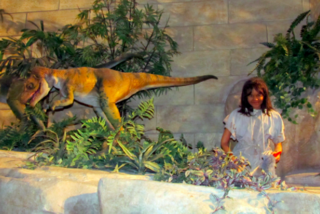Genetics
Yes, Humans and Animals Are 'Not So Different'
Striking behavioral similarities argue for shared ancestry.
Posted January 3, 2018
Not long after my 2016 book, "Not So Different" was published, Ken Ham put out a blog post denouncing the thesis of the book, that the behaviors of humans and other animals are not as different as they may appear.

In case you haven't heard of him, Ken Ham is the main force behind Answers in Genesis, a Christian ministry devoted to the literal interpretation of the Bible and the defense of young-earth creationist explanations of the universe and our place in it. Mr. Ham opened the world's only museum devoted to creationism and, more recently, the Ark Encounter.
I say that he denounced the thesis of my book, but not the book itself, because it is clear that he did not read the book, only a press release. He doesn't lie about that, but it's a shame that he didn't read it because then we might be able to debate some of the finer points of human and animal behavior that call out for an explanation.
Shared ancestry is the scientific explanation, but there are non-scientific alternative explanations as well, and Ken Ham is a major proponent of one of them: intelligent design. I would relish the opportunity to debate the origins of human behavior with Mr. Ham. In the spirit of debate, I would like to address some of the points raised by Mr. Ham in his article and I invite him to do the same to my counter-points. I will do my best to be kind in my responses.
Evolutionists often emphasize small similarities between humans and animals and ignore the massive differences that separate us from animals in their attempt to show common descent.
Actually, ethologists and psychologists plainly admit the great leap that humanity has made when it comes to many forms of cognition. The "massive difference" that Mr. Ham refers to, however, is limited to introspection, advanced reasoning, and so forth, neural activities that are centered mostly in the pre-frontal cortex of the cerebrum. Nearly the entire rest of the human brain, and the whole rest of the body, is built almost exactly as that of other apes, with only subtle tweaks to skeletal anatomy.
Nothing about biology demonstrates that everything—including our behavior and anatomy—is a product of evolution. Actually, biology argues against evolutionary ideas.
This statement is a doozie because it strikes at the very heart of modern biological science. His disagreements with the modern practice of biology are fundamental. Biologists view everything, from molecules to populations, as the product of evolution, and Mr. Ham doesn't. There are no specifics here to argue - it's just a broad statement summarizing his wholesale rejection of evolutionary science, the foundational theory of modern biology.
The law of biogenesis states that life only comes from other life.
This is true, but I fail to see how it argues against the common ancestry of all animals. The law of biogenesis was the name given to the 19th century refutation of spontaneous generation. Rather than believing that meat could spontaneously give rise to maggots and soup could give rise to microbes, the law of biogenesis said that all living things came from pre-existing living things. There is little to disagree on here.
However, I am guessing that Mr. Ham extrapolates this infinitely backward as a way to argue that evolution cannot explain the emergence of life on a lifeless planet and therefore evolutionary theory is insufficient. The concept of abiogenesis is too big for this blog post and far outside the realm of my book, but I've written a couple articles on it here and here.
Natural selection and mutations—the supposed driving forces of evolution—actually cause changes that lead in the opposite direction of pond-scum-to-people evolution by deleting or rearranging information rather than adding brand-new genetic information for new traits.
Mr. Ham is correct that mutations can have the effect of destroying information found in the genetic code. Many mutations are deleterious to the gene and organism in which they occur. These harmful mutations are eliminated from the population shortly after they emerge through the failure of the individual(s) that harbor them to thrive.
However, very rarely, a random mutation can cause a fortunate accident that gives new or improved function to a gene. This is the vehicle of evolutionary innovation. Most mutations, however, are actually neutral and accumulate harmlessly in our genomes. Because these harmless mutations occur at a more or less steady rate, they can be used to calculate the approximate age of splits in ancestral lineages in deep time. In sum, Mr. Ham talks of mutations as if there is only one kind - the harmful kind. Most are actually neutral and a small percentage actually improve the function of the gene in which they happen.
Now, this evolutionist has exposed his underlying presupposition that evolution has happened, and this presupposition colors what he thinks and writes about. What if we changed the presupposition?
Herein is the major flaw in his thinking about evolution. The theory of evolution by natural selection is not a presupposition. Naturalists had searched for the mechanism of adaptive change for centuries before Darwin and Wallace started us down the right track. (Yes, most scientists already accepted that species change over time well before Darwin.) The principle of evolution by natural selection has been painstakingly scrutinized, debated, and refined over the 150 years since Darwin first outlined its general mechanism. No idea has ever been tested so many times and in so many ways.
Still today, every single experiment, study, and research paper in the field of evolutionary biology puts the theory to the test by testing one or more of its many predictions. When we test the predictions of a theory, we are also testing the underlying theory itself. If the theory of evolution was a wrong, we'd surely know by now. If evolution is now thought of as a presupposition, it is only because no serious doubt remains in the scientific community, given how thoroughly evolution has been studied, and continues to be studied.
A great example of this is the “guilty” look dogs are said to give their owners when they’ve done something wrong. Well, researchers have shown that the dogs aren’t actually showing signs of guilt—they are merely trying to avoid your displeasure. And yet we often believe our dogs really do feel guilty for what they’ve done.
Mr. Ham is misreading the paper he cites and robbing his example of the proper context. In fact, I wrote about this very phenomenon in the book that he chose to criticize without reading! (Summarized again here.) The "guilty look" in dogs is what is known as a borrowed signal. The posture of the guilty dog mirrors that of the signal for submission. Dogs and wolves in the wild use this signal to submit to a more dominant individual in the social hierarchy as a sort of "apology" for an infraction.
Social mammals have rules and there are punishments and apologies for breaking them. This borrowing of a signal makes sense because never are we more submissive than when we're apologizing. It is not to avoid our "displeasure" but to facilitate re-entry into the social group and avoid harsh punishment. Mr. Ham is right to question whether we can know if a dog is actually feeling guilt. We can't. But that misses the point. The behaviors associated with apologies and submission are shared between humans and animals, although the signals themselves are not. (For example, to express apology and reconciliation, humans borrow signals of greeting and affiliation, such as handshakes or hugs.)
By the way, I often tell people who visit the Creation Museum and Ark Encounter, 'If you want to illustrate how different humans, made in the image of God, are from animals, go to our petting zoos and just try to have a conversation with one of the animals!'
The fact that humans have complex language is truly remarkable and probably the feature that allowed the explosion of accumulated knowledge and culture that eventually led to the emergence of settlements, agriculture, technology, civilization, and, eventually, modernity. But just because we speak a different language from animals, doesn't mean we're not related to them. I speak a different language from my great-great-grandmother and she's my direct ancestor!
Also, Mr. Ham might be surprised at how complex animal communication is. I've written about the language of prairie dogs here, primates here, bonobos here, and the three apes that learned human language here. While human language is truly impressive, we didn't evolve it from scratch.
---

I hope that Mr. Ham will read my book. You don't have to accept evolution and shared ancestry to enjoy the book, as long as you can appreciate the many parallels between human and animal behavior, whatever their origin.
References
Lents, NH. "Not So Different: Finding Human Nature in Animals" Columbia University Press. 2016.




